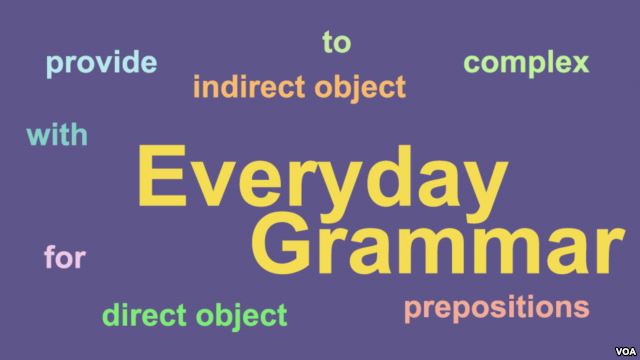VOA慢速英语:每日语法:关系代词
A relative pronoun relates to the noun it is describing. Relative pronouns introduce a relative clause. Think of relative clauses as long adjectives. Adjectives are words that describe nouns.
Let's start with an example sentence:
The woman who called me yesterday was my mother.
In this sentence who is the relative pronoun, and who called me yesterday is the relative clause. The clause is describing the nounwoman.
In general, the relative pronouns who, that, and which do one of two things:
1. They help identify the noun or
2. They help give more information about the noun.
In the example sentence, the clause "who called me yesterday" identifies the noun, in this case woman.
 |
When a relative clause adds more information about the noun, the clause is surrounded by commas. Here is an example sentence:
My mother, who called me yesterday, says she is coming to visit me this summer.
Who is just one example of a relative pronoun that you can use when talking about a person. Let's listen to a scene from the comedy film Bridesmaids for another example. In this scene, the main character Annie is telling her best friend that she has changed. Listen for the relative pronoun:
"Lillian, this is not the you that I know! The you that I know would have walked in here and rolled your eyes and thought that this was completely over the top, ridiculous, and stupid!"
The relative pronoun Annie used in the scene is that -- when she says "the you that I know." In this sentence, that I know describes the noun you.
Both who and that can be used in relative clauses that describe a person. That can also be used to describe a thing. For example:
"The bike that I bought last week was stolen." The relative clause "that I bought yesterday" describes the noun bike.
The relative pronoun which is also used to describe a thing.
Here is an example sentence using which.
"My bike, which I bought last week, was stolen."
In this example, the relative clause "which I bought last week" adds more information about the noun bike. The clause is surrounded by commas.
Here are some general rules about commas and relative clauses:
--If the clause begins with the relative pronoun that, you do not need commas.
--If the clause begins with the relative pronoun which, you generally need commas.
--If the clause begins with the relative pronoun who, you need commas if the clause is adding additional information about the noun.
Here is an example sentence using the relative pronoun who, with and without commas.
1. My sister who lives in New York bought an apartment
2. My sister, who lives in New York, bought an apartment.
In the first sentence, the relative clause who lives in New York is identifying the noun sister. The speaker might have more than one sister. The clause "who lives in New York" is identifying which sister he or she is talking about.
In the second sentence, the same relative clause is adding additional information about the noun sister.
Sometimes, English speakers remove the relative pronoun altogether. Listen for the relative clauses in Shania Twain's song You're Still the One.
You're still the one
You're still the one that I love
The only one I dream of
You're still the one I kiss good night
In one line, she keeps the relative pronoun that. In the rest, she omits -- or removes -- the relative pronoun. If the relative pronouns that and who are followed by a noun or pronoun, they can be omitted. That makes the sentences "You're still the one that I love" and "You're still the one I love" both correct.
We can talk about other relative pronouns in another episode of Everyday Grammar. But for now, listen for the relative pronouns as we end this episode with the David Bowie song "The Man Who Sold the World."
You're face to face
With the man who sold the world.
I'm Jonathan Evans.
And I'm Ashley Thompson.
Ashley Thompson wrote this story for VOA Learning English. Adam Brock edited and produced it.
Now it's your turn. Practice using relative pronouns by describing your best friend. Start with this: "My best friend is someone who ______"
______________________________________________________________
Words in This Story
relate - v. to show or make a connection between (two or more things)
identify - v. to show who someone is or what something is
surround - v. to be on every side of something
- 频道推荐
- |
- 全站推荐
- 推荐下载
- 网站推荐




















